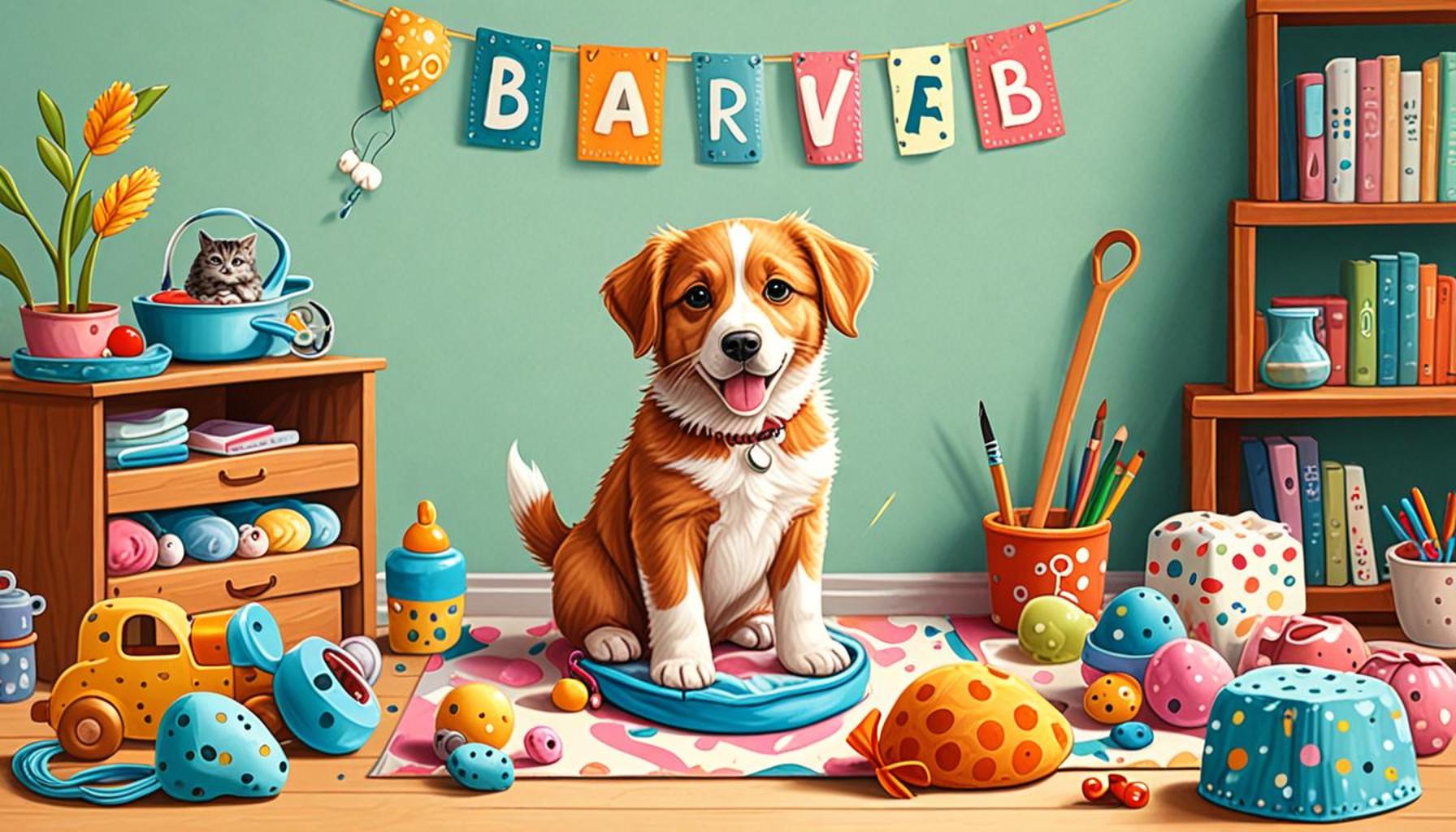How to Prepare Your Pet for the Arrival of a Baby at Home

Welcoming a New Addition
Bringing a new baby home is a joyous occasion, but it can also be a time of uncertainty for your beloved pet. Preparing your pet for this life-changing event is essential to ensure smooth transitions for everyone involved. The manner in which you approach this change can greatly influence your pet’s behavior and your family’s enjoyment of the new addition. This task requires foresight and sensitivity, given that family pets can feel a range of emotions, including anxiety, confusion, and even jealousy.
Understanding Your Pet’s Needs
Pets, just like humans, can feel anxiety and confusion when their environment changes. Here are some key factors to consider:
- Routine adjustment: Pets thrive on routine; be prepared to modify theirs. For example, if your dog is accustomed to daily walks at a certain time, try to maintain that schedule, or adjust it to fit the new family dynamic. A consistent routine can provide a sense of stability for your pet amidst the changes happening in the household.
- Social time: Ensure your pet still receives attention and social interaction. It’s crucial to dedicate specific times daily for cuddles or playtime, even as you juggle your new responsibilities. A little extra love can go a long way in assuring your pet feels valued and secure.
- Safe spaces: Create areas where your pet can retreat when feeling overwhelmed. Designating a quiet nook or a cozy corner in your home equipped with familiar toys and blankets can offer a sanctuary where your pet can decompress, especially during the noisier infant transitions.
Introducing the Baby
Gradual introductions between your pet and the new baby are crucial. This process should be gradual and supportive, promoting positive associations. Some strategies include:
- Let your pet sniff baby items before the arrival. Introducing them to the smell of baby clothes or blankets can pique their curiosity and familiarization with the change.
- Play recordings of baby sounds to get your pet accustomed. This could include cooing or crying sounds, which can help ease your pet into the new audio landscape they will experience once the baby is home.
- Use treats to reward good behavior during the introduction. Positive reinforcement can help your pet associate the baby’s presence with pleasant experiences, fostering a bond between them.
Taking the time to prepare can help your pet feel included, lowering the stress for both them and your family. Engaging a pet trainer or behaviorist during this transition can provide additional tailored guidance suited to your specific pet’s needs. In this guide, we will explore practical steps and expert tips to ensure a harmonious transition as you welcome your baby into your home.
DISCOVER MORE: Click here to learn about the benefits of pet adoption
Creating a Calm Transition for Your Pet
As the big day approaches, implementing plans to ensure your pet feels secure is vital. A peaceful coexistence begins with understanding how to manage your pet’s environment and the dynamics at play in your home. A well-prepared home can make a significant difference in how your pet reacts to the new addition. The goal is to foster an atmosphere of calm and reassurance, establishing a foundation for your family’s new normal.
Assessing Your Pet’s Behavior
Before the baby arrives, it’s crucial to gauge your pet’s current behavior and assess any potential anxieties they may have. Every pet is unique, and understanding your pet’s temperament can help you prepare effectively. Here are some behavioral aspects to consider:
- Signs of Stress: Look for changes in your pet’s behavior, such as increased barking, destructive chewing, or marking territory. Recognizing these signs can help you manage their anxiety effectively.
- Sensitivity to Noises: If your pet tends to be skittish around loud sounds, this could indicate a need for special attention. Consider sound therapy or exposure to various audio stimuli before the baby arrives to acclimate your pet gradually.
- Previous Interactions with Children: Evaluate how your pet has behaved around young children in the past. This will give you insight into how they might react to a baby at home.
Preparing Your Home
Creating a pet-friendly environment that adapts to the needs of a newborn is essential in easing the transition. Here are some practical modifications you can make around your house:
- Set Boundaries: Designate areas in your home that are off-limits to your pet and create safe spaces for both the baby and your pet. This can include baby rooms or play areas where your pet knows they are not allowed.
- Comfortable Zones: Ensure your pet has comfortable areas to relax, preferably away from the baby’s potential noise and chaos. This can help reduce the likelihood of anxiety or jealousy.
- Equip for Baby’s Arrival: Stock up on baby essentials, and introduce your pet to these items slowly to avoid overwhelming them. Allow them to examine baby toys, rattles, and clothing as a way to understand the changes coming up.
Overall, the process of preparing your pet for the arrival of a baby involves proactive strategies and adjustments. Actively working to create a nurturing environment not only helps your pet feel secure but also builds a sense of harmony in your home. In the next part of this guide, we’ll dive deeper into the methods for introducing your baby to your beloved pet, ensuring a seamless and enjoyable meeting for both parties.
| Category | Advantages |
|---|---|
| Training and Socialization | Encourages positive behavior, reducing anxiety as they adjust to new family dynamics. |
| Gradual Exposure | Familiarizes pets with baby sounds, smells, and activities, making the transition smoother and less stressful. |
| Separate Spaces | Creates a safe zone for pets, allowing them to retreat when they feel overwhelmed. |
| Positive Reinforcement | Helps pets associate the arrival of the baby with fun and rewards, fostering loyalty and love. |
When preparing your pet to welcome a newborn into the home, it is vital to recognize the pet’s emotional needs. Training and socialization can encourage positive interactions and significantly reduce anxiety during what can be a disruptive time for pets. Gradual exposure to sounds and items associated with babies helps alleviate any fears that may arise from sudden changes in their environment.Additionally, ensuring that your pet has a safe space away from potential chaos can help them feel more secure. A quiet area can serve as their sanctuary when the excitement gets overwhelming. Using positive reinforcement techniques, such as treats and praise, can generate excitement about the baby’s arrival, turning potentially stress-inducing moments into opportunities for bonding. Through these careful preparations, pets can smoothly adjust to the new family member with love and enthusiasm.
LEARN MORE: Click here to discover how to keep your pet safe
Introducing Your Pet to the New Family Member
Once the baby arrives and you have established a safe and secure environment for your pet, the next step is to manage the introduction between your pet and the newborn. This process requires careful planning and patience to ensure a positive experience for everyone involved. The goal is to create a bond based on trust, familiarity, and safety.
Initial Introductions
The first meeting between your pet and the baby should be handled with utmost care. Here are some steps to consider for a smooth introduction:
- Maintain a Calm Atmosphere: Prior to the introduction, ensure both the baby and pet are in a calm state. It’s wise to begin the meeting in a quiet room, minimizing distractions or excessive stimulation. Consider having someone else hold the baby while you attend to your pet.
- Introduce Scent First: Before the baby arrives home, bring a piece of the baby’s clothing or a receiving blanket for your pet to sniff. Familiarizing your pet with the baby’s scent can make the eventual introduction less daunting.
- Short and Positive Encounters: Keep initial interactions brief but positive. Allow your pet to come close to the baby while ensuring adequate supervision. If your pet shows signs of stress, remove them from the situation and try again later.
Managing Pet Behavior
As a new parent, it’s crucial to monitor your pet’s behavior closely during this transition. Not every pet will automatically embrace the new family member, and some may exhibit changes in emotions or actions. Here are ways to manage your pet’s behavior effectively:
- Reward Good Interactions: When your pet behaves well around the baby, be sure to reward them with treats or praise. Positive reinforcement encourages repeat good behavior and helps them associate the baby with positive experiences.
- Consistency is Key: Establish and communicate clear rules and boundaries for your pet regarding interactions with the baby. This consistency will help them understand acceptable behaviors over time.
- Attention and Affection: When the baby arrives, don’t forget about your pet’s need for attention. Continuously engage with your pet and maintain routines they are accustomed to, ensuring that they don’t feel neglected during this busy transition.
Safety First
Ensuring the safety of both your baby and your pet is your top priority. Pets can sometimes react unexpectedly, and it is essential to be prepared:
- Supervise All Interactions: Always supervise interactions between pets and babies, especially during the first few months when both are getting used to one another. Use baby gates or a pen to create a barrier when you can’t give them your full attention.
- Teach ‘Gentle’ Commands: If your pet is large or excitable, training them with commands like “gentle” or “easy” can help control their behavior around the baby. Reinforcing calmness will encourage a safer environment for play and bonding.
- Educate Older Children: If you have older children, teach them how to interact with the pet safely and respectfully. This lesson will help them understand the importance of giving pets their space and will foster a sense of responsibility.
Thorough preparation will pave the way for a smooth transition when introducing your pet to the newest family member. By taking the time to manage the environment, direct behavior, and supervise interactions, you can facilitate a positive and enriching relationship between your pet and your baby.
LEARN MORE: Click here to discover the best options for your pet
Conclusion
Preparing your pet for the arrival of a baby at home is not only a thoughtful decision but also an essential one for the well-being of both your furry friend and your new family member. By understanding your pet’s behavior, managing introductions carefully, and ensuring safety in all interactions, you create an environment that fosters harmony and affection. Remember, this transition period may be challenging, but it’s vital for establishing a lifelong bond between your pet and your child.
Engaging in consistent training and providing your pet with reassurance during this time can significantly ease anxiety and promote positive reactions towards the baby. Every pet is unique, and their adaptability may vary; therefore, patience will be your best ally in navigating this new chapter.
Additionally, consider incorporating regular routines for your pet even after the baby arrives. Maintain designated playtime and quality interactions to help your pet not feel neglected or displaced. Keeping an open line of communication with other family members about shared responsibilities can also streamline the adjustment process.
Ultimately, with preparation, understanding, and love, you can cultivate a setting where both your pet and baby thrive together. As they grow, fostering a respectful and affectionate relationship between them will enrich the lives of your entire family. So, embark on this journey with optimism, knowing you’ve equipped both your pet and your baby for a shared future filled with joy.


